A Power-Efficient Clustering Protocol for Coal Mine Face Monitoring with Wireless Sensor Networks Under Channel Fading Conditions
Abstract
:1. Introduction
2. Network Model and Channel Fading Characteristics
2.1. Network Model
2.2. Influence of Environmental Factors on Channel Fading
3. Cluster Routing Protocol
- (1)
- To maintain the optimal number of CHs, we consider that the number of nodes actually participating in data transmission in a network changes continuously because some nodes run out of energy; the original fixed number of CHs also changes accordingly (mainly depending on the number of active nodes and the rate of generating CHs); and .
- (2)
- To keep the number of CHs in each round under the optimum, the use of a random number of each node compared with the threshold used for CH selection is improved and corrected from the original fixed variation range of [0,1] to a self-adapting variable sliding window Wr.
- (3)
- The original threshold T(n) is improved in two ways: the total number N of deployment nodes in the original threshold is replaced by the number of active nodes Nactive to better guarantee that the number of CHs formed in each round follows optimization, and a node residual energy ratio factor and channel efficiency ratio factor are introduced.
- (4)
- When member nodes select their own CH to join, the final communication loss of data transmission to the BS should be considered instead of simply the distance and energy factors because in a channel fading environment, the energy consumed by nodes at the same distance while successfully transmitting equivalent data may be different; this is mainly affected by channel fading.
3.1. Initialization Stage
3.2. CH Selection
3.3. Cluster Formation
| Algorithm 1 PEAFC-CL |
| Upon Timer |
| BS: broadcast “” frame in network |
| foreach sensor node do |
| Reset to 0 |
| Upon receiving a beacon frame from BS |
| Compute |
| send “” frame (contain: , , ) |
| end |
| Upon receiving a Probe request frame from |
| BS compute: , , , , , |
| If < current time < then |
| BS broadcast “” (contain: , , , , , ) |
| foreach sensor node do |
| ← Random (0, ) |
| If < then |
| Be cluster head ← |
| else |
| Be cluster head ← |
| end |
| end |
| else if < current time < then |
| foreach CH node do |
| Broadcast “” message |
| Upon receivingh a “” message |
| if then |
| Record information contained in “” |
| Add to CH Member node list |
| else |
| Discard “” |
| end |
| end |
| foreach CM node do |
| Upon receivingh a “” message |
| Compute: , |
| If and then |
| Broadcast “” message |
| end if |
| end |
| end |
3.4. Route Selection
3.5. Data Transmission Stage
4. Energy Consumption Model and Power Control
4.1. Energy Consumption Model
4.2. Power Control
5. Performance Analysis
5.1. Message Complexity
5.2. Proof of Cluster Heads Expectation
- (1)
- When , there are and . At the current time of the network, the sum of the residual energy of all nodes is equal to times the average energy, that is:and ; thus, when for the first round of a cycle, the expected number of CHs in the network is :
- (2)
- When , that is, nodes are selected as CHs after one round, there is :
- (3)
- When and , that is, nodes are selected as the CH after rounds, there is:therefore:
6. Experimental Simulation and Analysis of the Results
6.1. Selection of Parameter
6.2. Number of CHs
6.3. Comparison of Network Lifetime
6.4. Influence of Channel Fading on The Network
6.5. Performance Gains from Cross-Layer Optimization
7. Conclusions
Acknowledgments
Author Contributions
Conflicts of Interest
References
- Brown, W.C. The history of power transmission by radio waves. IEEE Trans. Microw. Theory. Tech. 1984, 32, 1230–1242. [Google Scholar] [CrossRef]
- Chao, R.Y.; Chung, K.S. A low profile antenna array for underground mine communication. In Proceedings of the International Conference on Computational Science, Singapore, Singapore, 14–18 November 1994; pp. 705–709.
- Western Australian: Virtual Miners Memorial. Mining Accidents Database. Available online: http://www.wavmm.com/mining-accidents-database/ (accessed on 2 June 2016).
- Bandyopadhyay, L.K.; Chaulya, S.K.; Mishra, P.K. Wireless Communication in Underground Mines: RFID-Based Sensor Networking; Springer-Verlag: New York, NY, USA, 2009. [Google Scholar]
- Sun, J.P. Characteristics of Coal Mine Accidents and New Technologies of Coal Mine Communication, Personnel Positioning and Monitoring. Ind. Mine Autom. 2015, 41, 1–5. [Google Scholar]
- Thring, M.W. Automation in coal mining. Long Range Plan. 1983, 16, 66–75. [Google Scholar] [CrossRef]
- Jonathon, R.; David, R.; Chad, H.; David, H. Sensing for advancing mining automation capability: A review of underground automation technology development. Int. J. Min. Sci. Technol. 2014, 24, 305–310. [Google Scholar]
- Large, D.B.; Ball, L.; Farstad, A.J. Radio Transmission to and From Underground Coal Mines—Theory and Measurement. IEEE Trans. Commun. 1973, 21, 194–202. [Google Scholar] [CrossRef]
- Forrest, R.T. A practical approach to radio propagation measurements-as used in the design of mobile radio communications systems. IEEE Trans. Veh. Technol. 1975, 24, 46–53. [Google Scholar] [CrossRef]
- Stoica, L.; Rabbachin, A.; Oppermann, I. Impulse radio based non-coherent uwb transceiver architectures—An example. In Proceedings of IEEE International Conference on Ultra Wideband Systems and Technologies, Waltham, UK, 24–27 September 2006; pp. 483–488.
- Serra, J.; Serra, J.; Pubill, D.; Antonopoulos, A.; Verikoukis, C. Smart HVAC Control in IoT: Energy Consumption Minimization with User Comfort Constraints. Sci. World J. 2014, 2014, 1–11. [Google Scholar] [CrossRef] [PubMed]
- Lindsey, S.; Raghavendra, C.; Sivalingam, K.M. Data gathering algorithms in sensor networks using energy metrics. IEEE Trans. Parallel Distrib. Syst. 2002, 13, 924–935. [Google Scholar] [CrossRef]
- Hakem, N.; Delisle, G.; Coulibaly, Y. Radio-wave propagation into an underground mine environment at 2.4 GHz, 5.8 GHz and 60 GHz. In Proceedings of the 8th European Conference on Antennas and Propagation, Hague, The Netherlands, 6–11 April 2014; pp. 3592–3595.
- Liu, X. A survey on clustering routing protocols in wireless sensor networks. Sensors 2012, 12, 11113–11153. [Google Scholar] [CrossRef] [PubMed]
- Soroush, N.; Hamidreza, G.; Chee-Onn, C.; Hiroshi, I. A Survey on the Taxonomy of Cluster-Based Routing Protocols for Homogeneous Wireless Sensor Networks. Sensors 2012, 12, 7350–7409. [Google Scholar]
- Heinzelman, W.B.; Chandrakasan, A.P.; Balakrishnan, H. An application-specific protocol architecture for wireless microsensor networks. IEEE Trans. Wirel. Commun. 2002, 1, 660–670. [Google Scholar] [CrossRef]
- Ali, M.S.; Dey, T.; Biswas, R. ALEACH: Advanced LEACH routing protocol for wireless microsensor networks. In Proceedings of the International Conference on Electrical and Computer Engineering, Dhaka, Bangladesh, 20–22 December 2008; pp. 909–914.
- Mehmood, A.; Lloret, J.; Noman, M.; Songet, H. Improvement of the wireless sensor network lifetime using LEACH with vice-cluster head. Adhoc Sens. Wirel. Netw. 2015, 28, 1–17. [Google Scholar]
- Abdulsalam, H.M.; Kamel, L.K. W-LEACH: Weighted Low Energy Adaptive Clustering Hierarchy Aggregation Algorithm for Data Streams in Wireless Sensor Networks. In Proceedings of the IEEE International Conference on Data Mining Workshops, Sydney, Australia, 13 December 2010; pp. 1–8.
- Zanjireh, M.M.; Shahrabi, A.; Larijani, H. ANCH: A New Clustering Algorithm for Wireless Sensor Networks. In Proceedings of 27th International Conference on Advanced Information Networking and Applications Workshops, Barcelona, Spain, 25–28 March 2013; pp. 450–455.
- Wei, D.; Jin, Y.; Vural, S.; Moessneret, K. An Energy-Efficient Clustering Solution for Wireless Sensor Networks. IEEE Trans. Wirel. Commun. 2011, 10, 3973–3983. [Google Scholar] [CrossRef] [Green Version]
- Long, C.; Liao, S.; Zou, X.; Zhou, X.M.; Zhang, N. An Improved LEACH Multi-Hop Routing Protocol Based on Genetic Algorithms for Heterogeneous Wireless Sensor Networks. J. Inf. Comput. Sci. 2014, 11, 415–424. [Google Scholar] [CrossRef]
- Tseng, C.C.; Chen, K.C. Layerless Design of a Power-efficient Clustering Algorithm for Wireless Ad Hoc Networks under Fading. Wirel. Pers. Commun. 2008, 44, 3–26. [Google Scholar] [CrossRef]
- Tian, Y.; Tang, Z.A.; Yu, Y. Energy-balanced Adaptive Clustering Routing for Indoor Wireless Sensor Networks. J. Electron. Inf. Technol. 2013, 35, 2992–2998. [Google Scholar] [CrossRef]
- Antonopoulos, A.; Renzo, M.; Verikoukis, C. Effect of Realistic Channel Conditions on the Energy Efficiency of Network Coding-Aided Cooperative MAC Protocols. IEEE Wirel. Commun. 2013, 20, 76–84. [Google Scholar] [CrossRef]
- Antonopoulos, A.; Lalos, A.; di Renzo, M.; Verikoukis, C. Cross-layer Theoretical Analysis of NC-Aided Cooperative ARQ Protocols in Correlated Shadowed Environments. IEEE Trans. Veh. Technol. 2015, 64, 4074–4087. [Google Scholar] [CrossRef]
- Fan, Q.G. Study on Equipments Positioning and Task Coordination for Three Machines Controlling on the Mechanized Mining Face. Ph.D. Thesis, China University of Mining and Technology, Xuzhou, China, 2013. [Google Scholar]
- Zhang, H.Q.; Ren, M.R.; Fan, Q.W.; Gao, X.J. Effection on wave propagation for Fresnel zone and obstacles underground tunnel. Chin. J. Radio Sci. 2007, 22, 200–202. [Google Scholar]
- Zhou, L.J.; Chen, G.Z.; Luo, C.M. Wireless Channel Modeling in Underground Coal Face Wireless Sensor Network. Chin. J. Sens. Actuators 2010, 23, 722–726. [Google Scholar]
- Forooshani, A.E.; Bashir, S.; Michelson, D.G.; Noghanian, S. A Survey of Wireless Communications and Propagation Modeling in Underground Mines. IEEE Commun. Surv. Tutor. 2013, 15, 1524–1545. [Google Scholar] [CrossRef]
- Zhang, Y.W.; Zhang, J.L. Influence of mine dust on propagation characteristic of UHF electromagnetic wave in tunnel. J. China Coal Soc. 2009, 34, 1554–1557. [Google Scholar]
- Zuniga, M.; Krishnamachari, B. Analyzing the transitional region in low power wireless links. In Proceedings of the First Annual IEEE Communications Society Conference on Sensor and Ad Hoc Communications and Networks, Los Angeles, CA, USA, 4–7 October 2004; pp. 517–526.
- Wang, B.; Lim, H.B.; Ma, D.; Fu, C. The hop count shift problem and its impacts on protocol design in wireless ad hoc networks. Telecommun. Syst. 2010, 44, 49–60. [Google Scholar] [CrossRef]
- Guan, J.M.; Yang, L.U.; Sheng, F.; Wang, J.W. On-demand routing protocol based on node’s capacity of access to medium for Ad Hoc networks. J. China Inst. Commun. 2007, 28, 32–37. [Google Scholar]
- Zhu, H.; Li, M.; Chlamtac, I.; Prabhakaran, B. A survey of quality of service in IEEE 802.11 networks. IEEE Wirel. Commun. 2004, 11, 6–14. [Google Scholar] [CrossRef]
- Chatzimisios, P.; Vitsas, V.; Boucouvalas, A.C. Throughput and delay analysis of IEEE 802.11 protocol. In Proceedings of the IEEE 5th International Workshop on Networked Appliance, Liverpool, UK, 31–31 October 2002; pp. 168–174.
- Gunes, M.; Hecker, M.; Bouazizi, I. Influence of adaptive RTS/CTS retransmissions on TCP in wireless and Ad-Hoc networks. In Proceedings of International Symposium on Computers and Communications, 30 June–3 July 2003; pp. 855–860.
- Yi, Z.; Adve, R.; Teng, J.L. Outage Probability at Arbitrary SNR in Cooperative Diversity Networks. IEEE Commun. Lett. 2005, 9, 700–702. [Google Scholar]
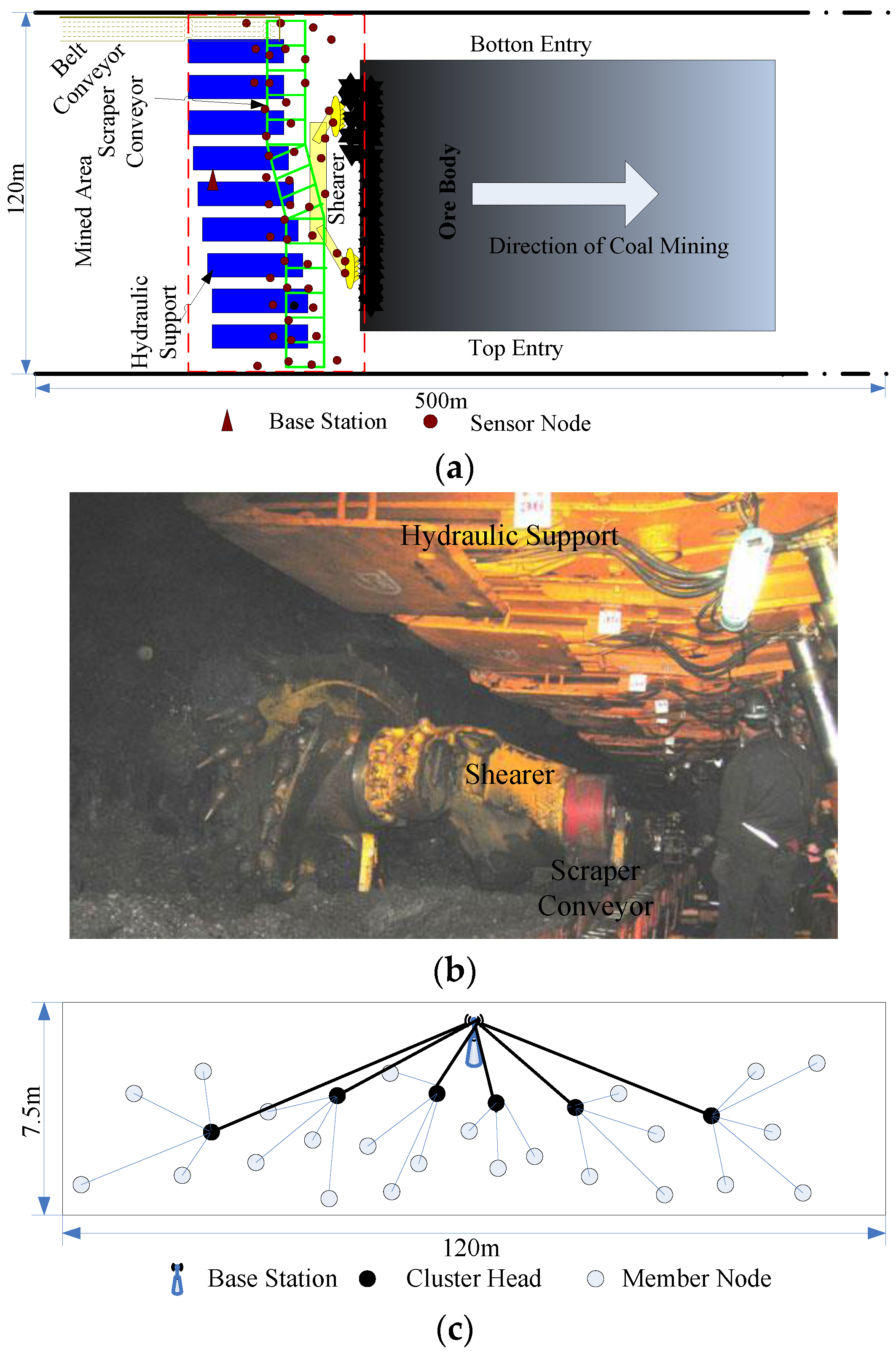

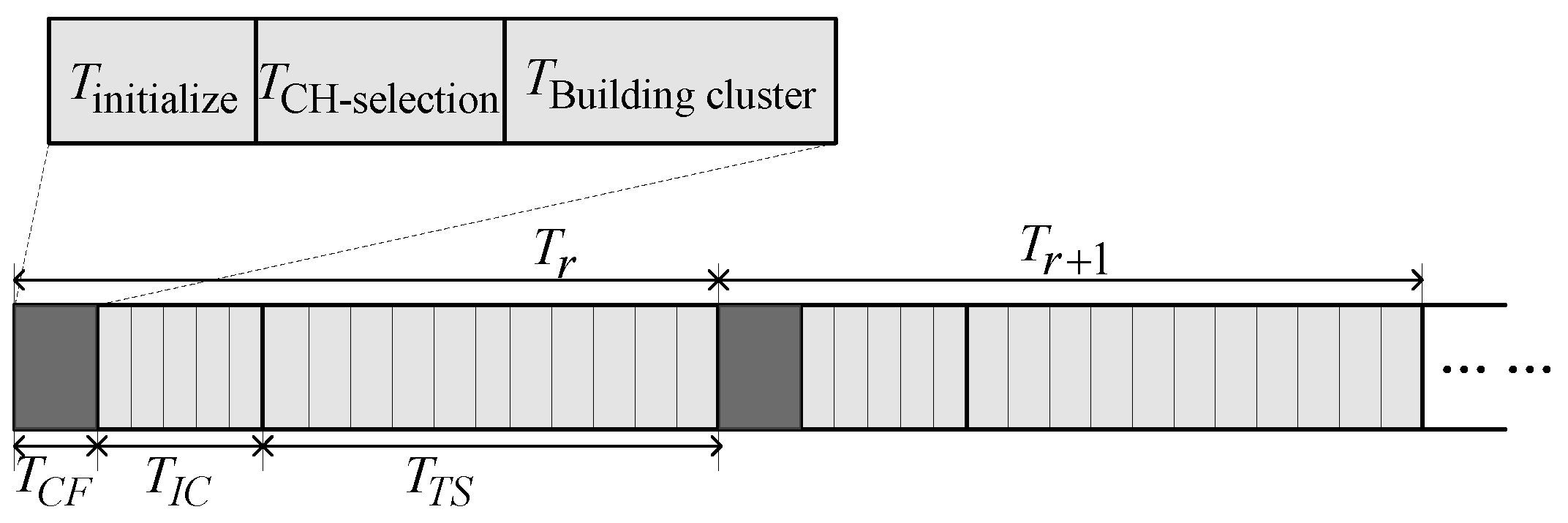

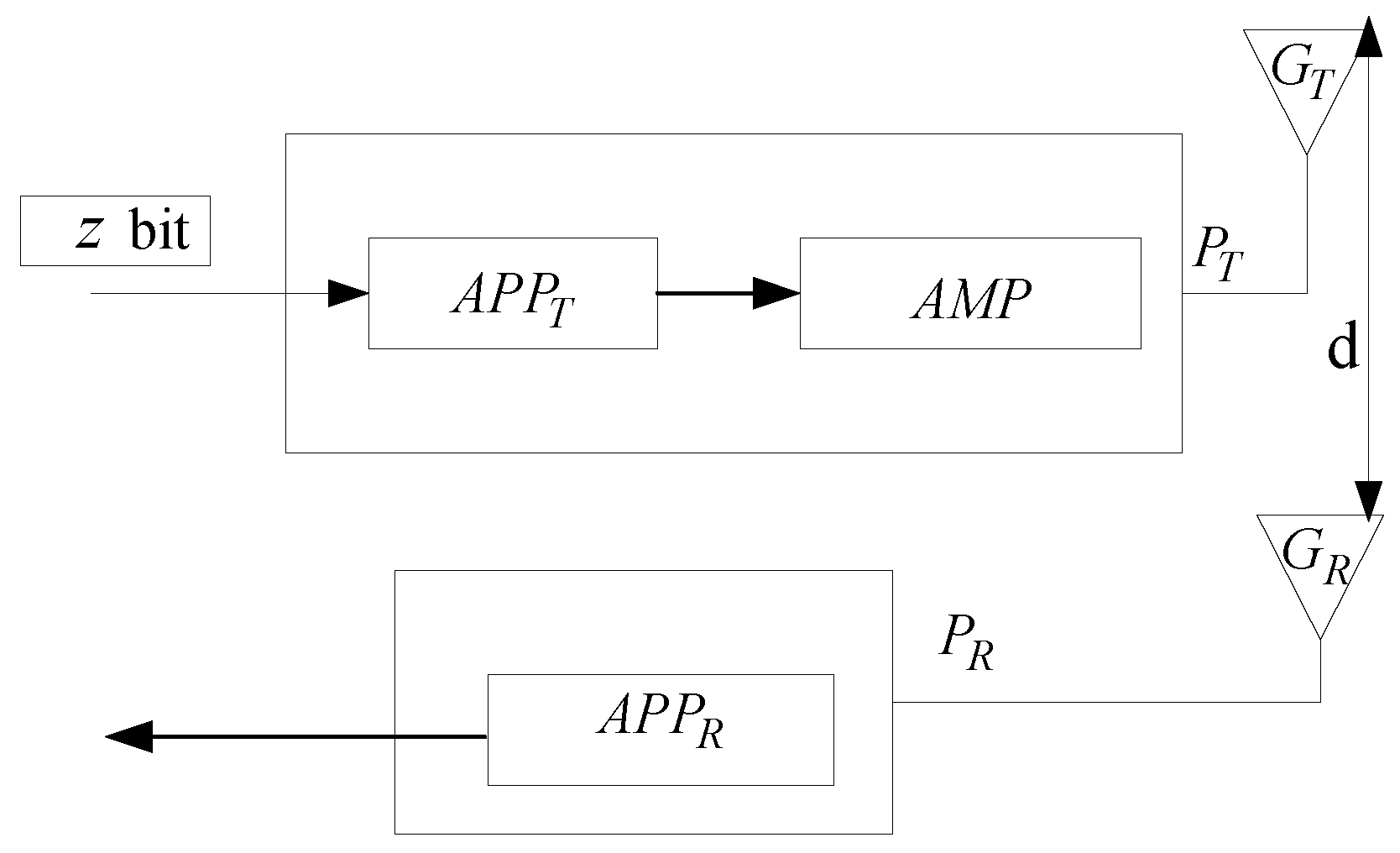

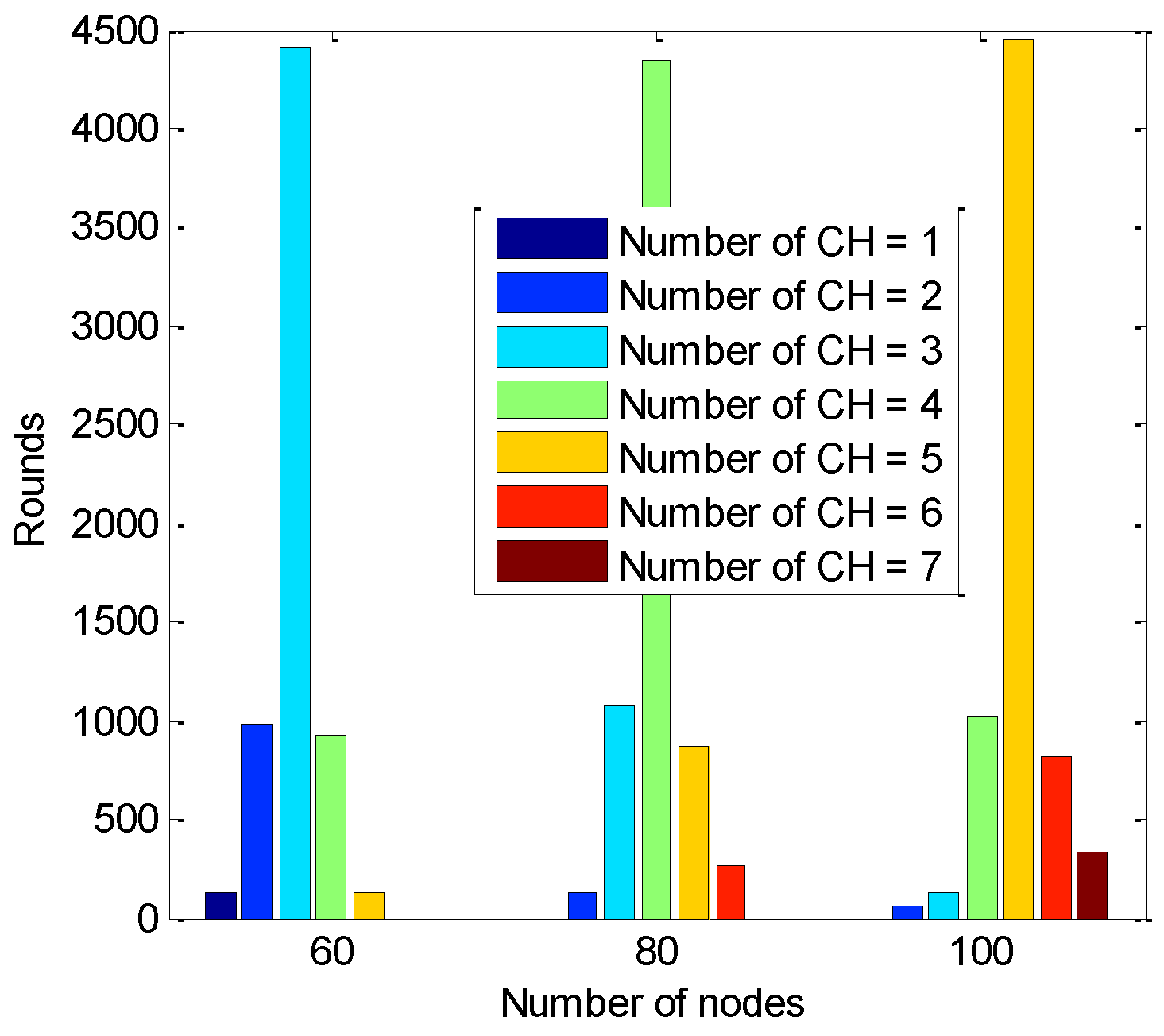

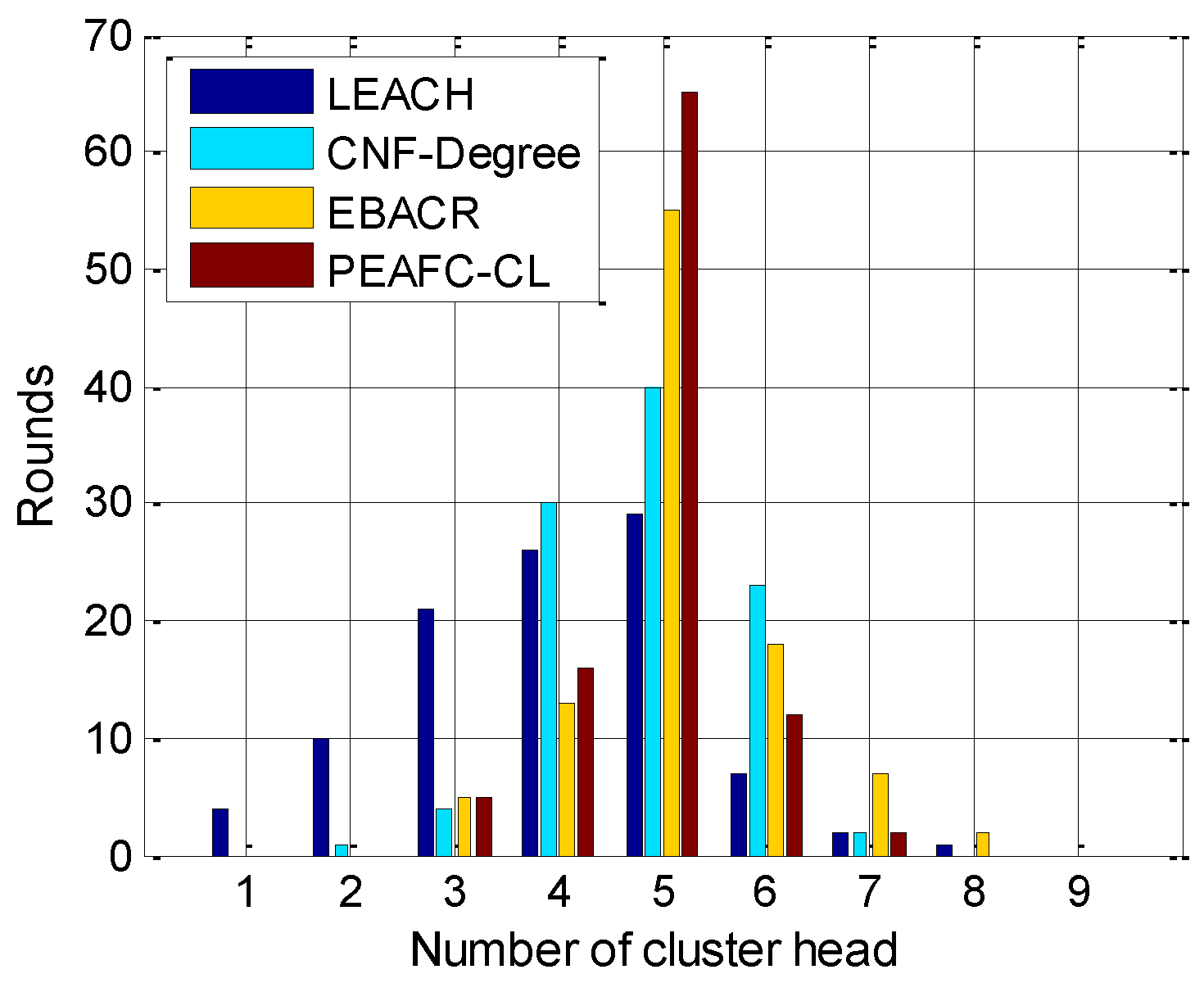
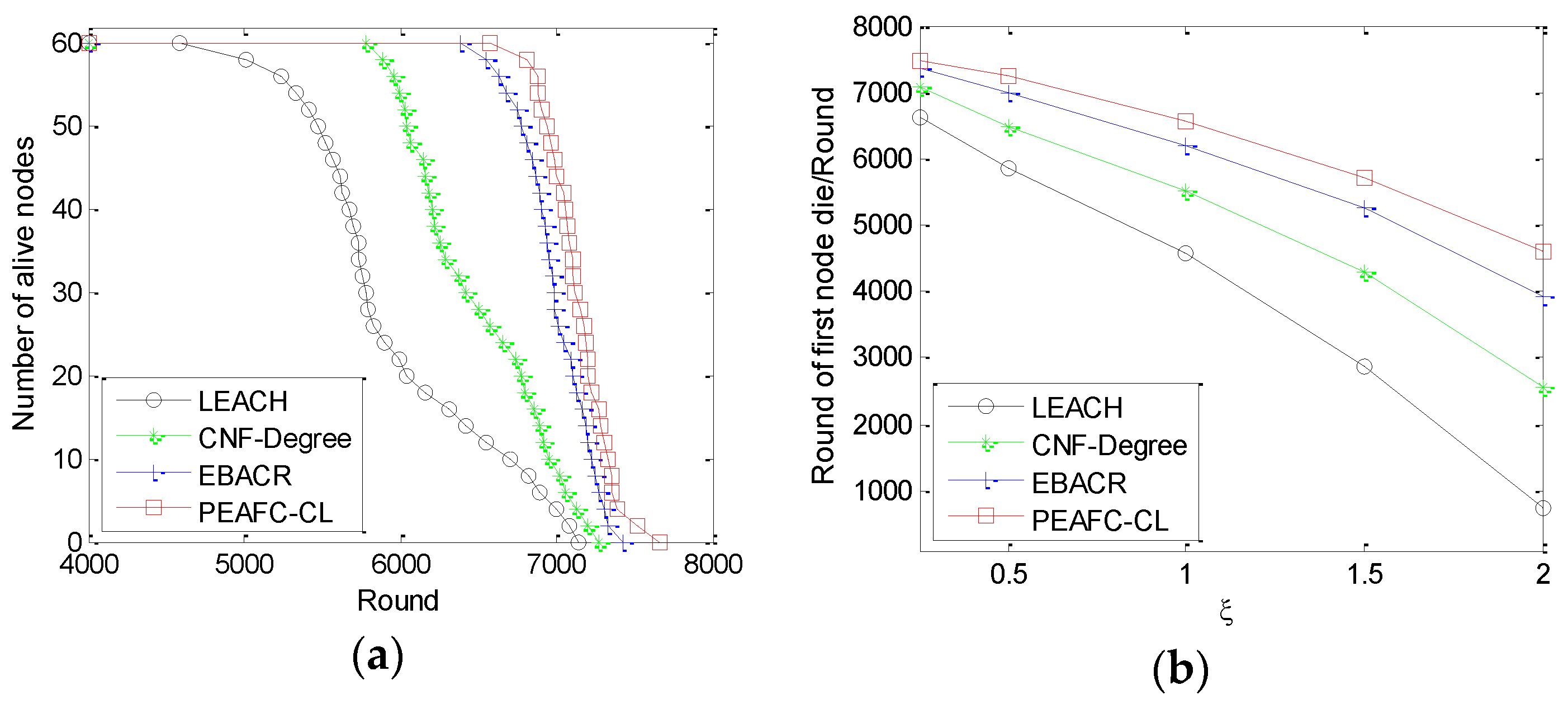
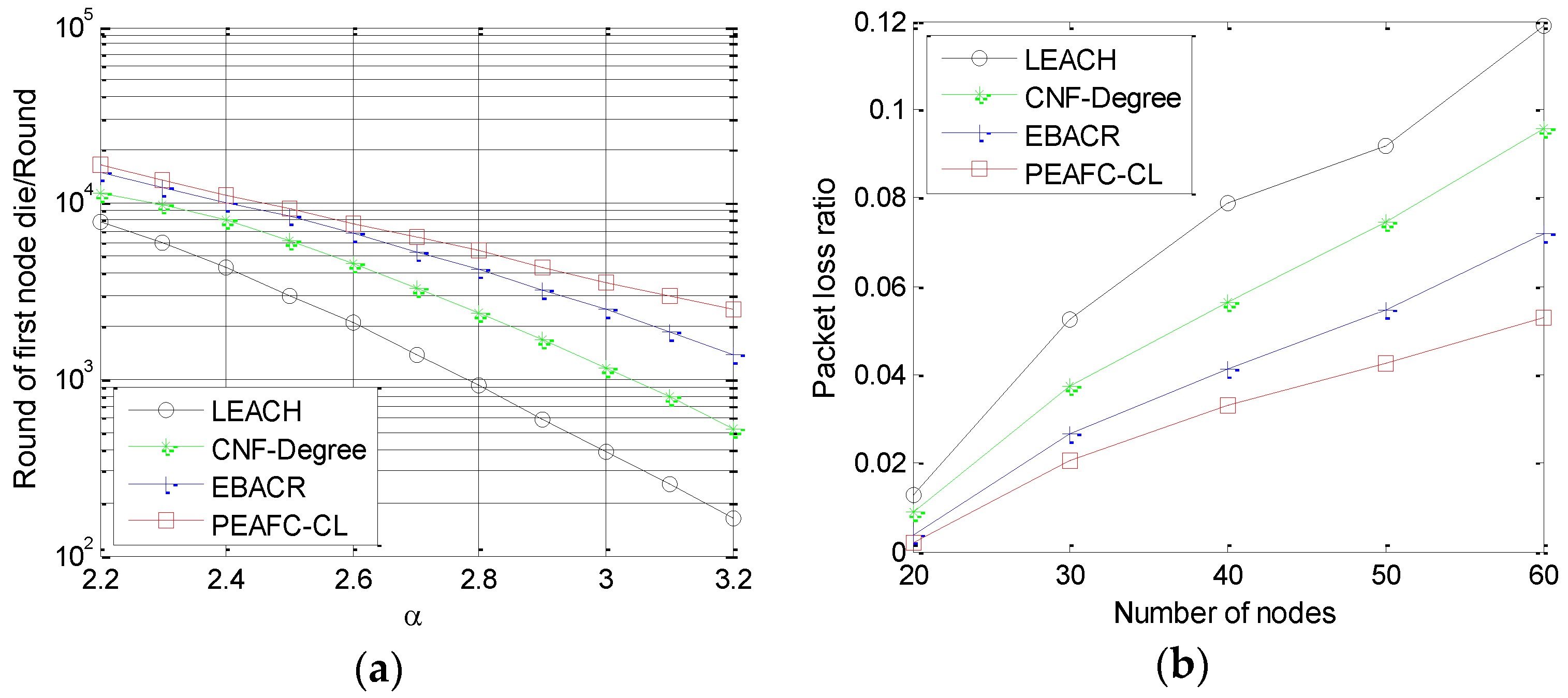
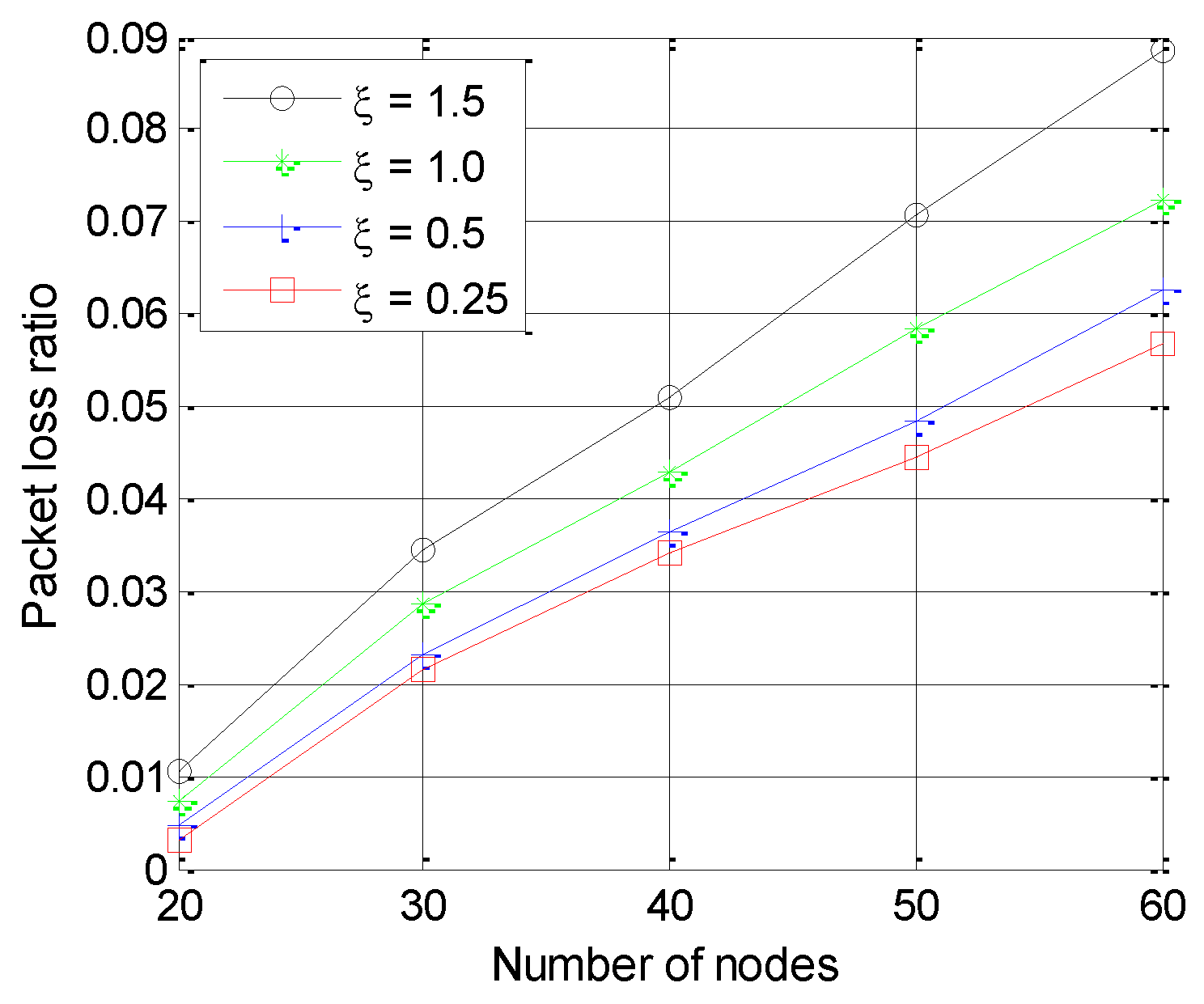
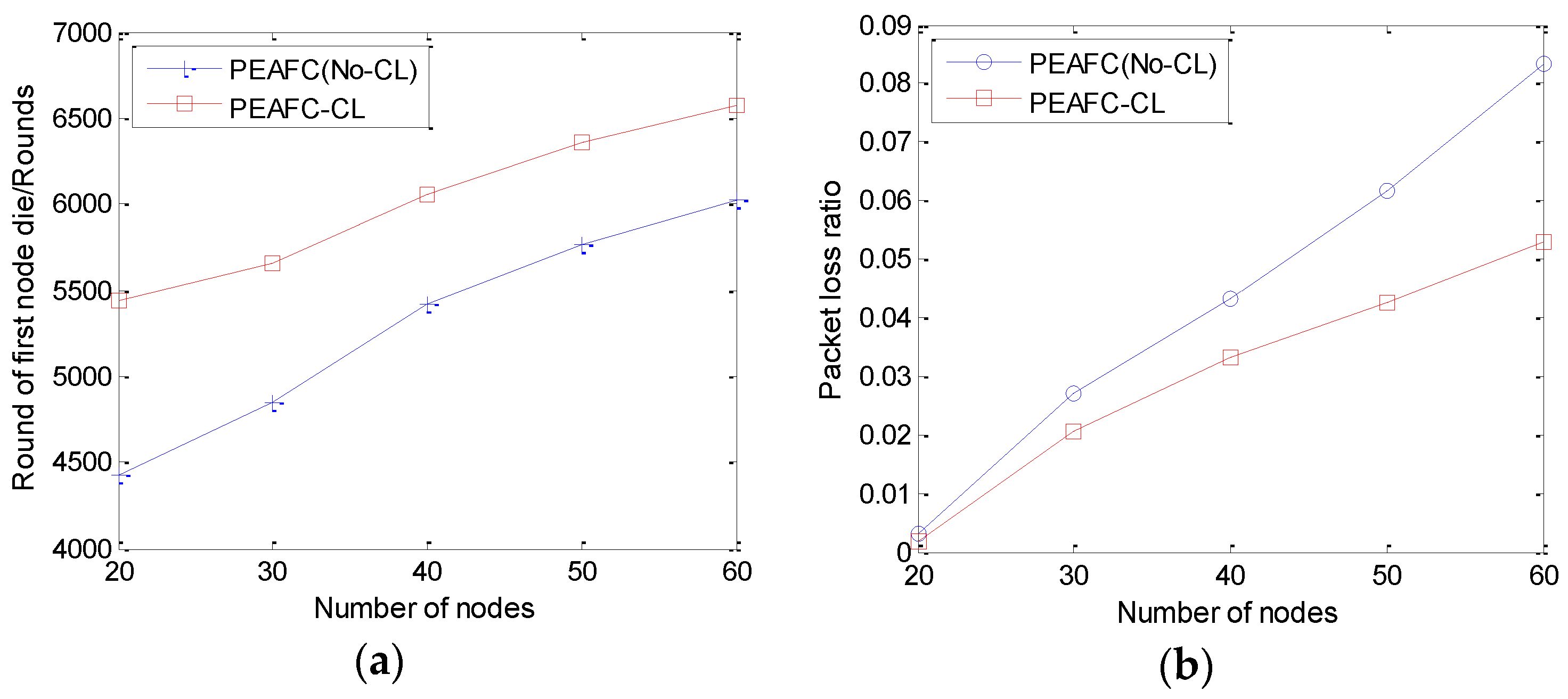
| Analytical CHs Expectation | Simulated CHs Expectation | Variance | |
|---|---|---|---|
| 5 | 5.011 | 0.64 | |
| 4 | 4.010 | 0.53 | |
| 3 | 2.992 | 0.45 |
| Parameter | Value | Parameter | Value |
|---|---|---|---|
| 2.4 GHz | 3.36 mW | ||
| 2.0–6.0 | 11.13 mW | ||
| 1–8 dB | 5.56 mW | ||
| 0.8 | 54 Mbit/s | ||
| 5.0 J | 1030 kHz | ||
| 5.92 pW | 3.4 pW | ||
| 0.12 | 0.01 | ||
| 0.05 | 30, 40, 60, 100 |
© 2016 by the authors; licensee MDPI, Basel, Switzerland. This article is an open access article distributed under the terms and conditions of the Creative Commons Attribution (CC-BY) license (http://creativecommons.org/licenses/by/4.0/).
Share and Cite
Ren, P.; Qian, J. A Power-Efficient Clustering Protocol for Coal Mine Face Monitoring with Wireless Sensor Networks Under Channel Fading Conditions. Sensors 2016, 16, 835. https://doi.org/10.3390/s16060835
Ren P, Qian J. A Power-Efficient Clustering Protocol for Coal Mine Face Monitoring with Wireless Sensor Networks Under Channel Fading Conditions. Sensors. 2016; 16(6):835. https://doi.org/10.3390/s16060835
Chicago/Turabian StyleRen, Peng, and Jiansheng Qian. 2016. "A Power-Efficient Clustering Protocol for Coal Mine Face Monitoring with Wireless Sensor Networks Under Channel Fading Conditions" Sensors 16, no. 6: 835. https://doi.org/10.3390/s16060835





